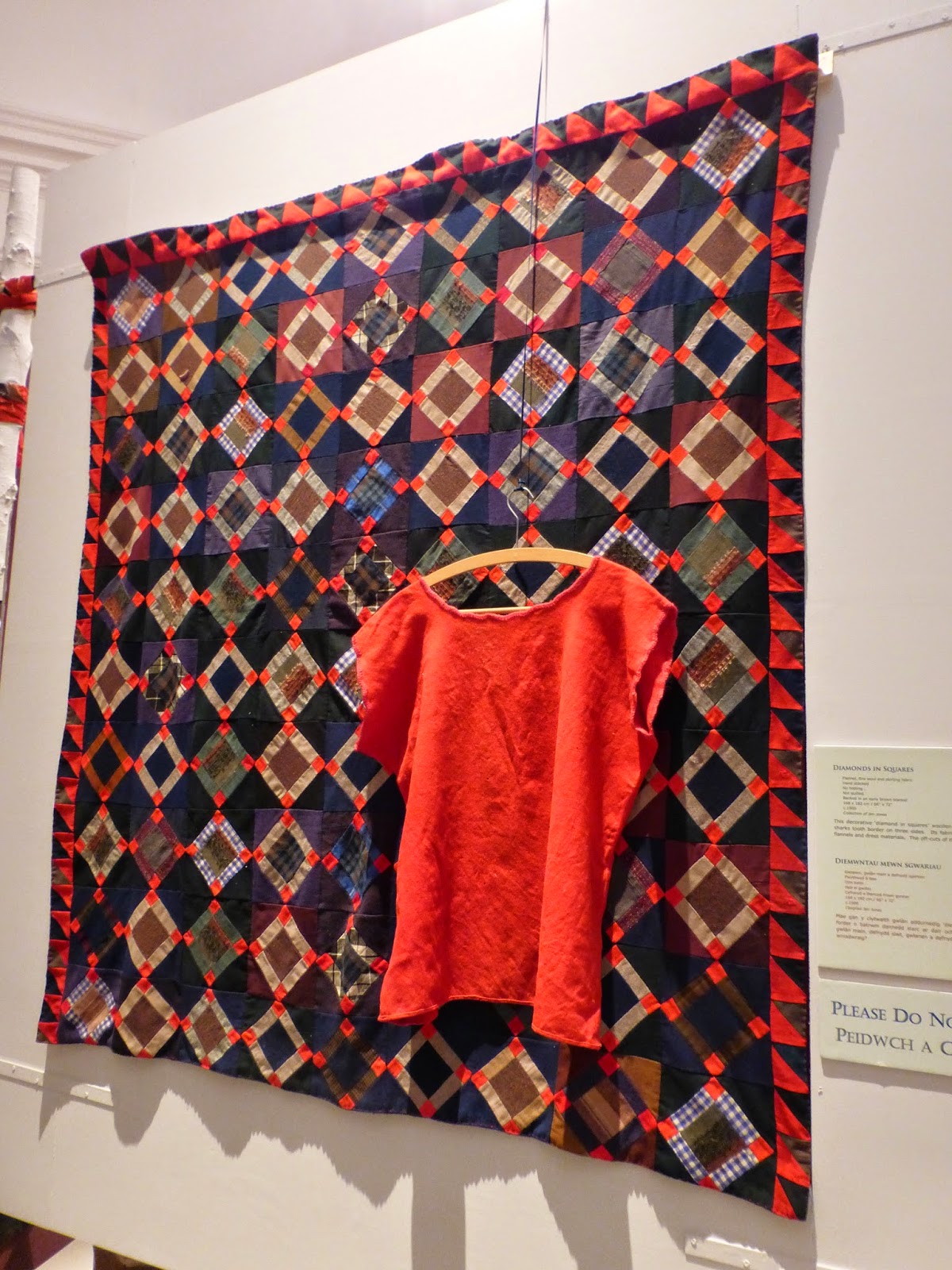Here are some details from the 'Early to Bed' exhibition at the Welsh Quilt Centre. It closed on Saturday, so if you didn't get to visit, you've missed it. The exhibition catalogue is available by mail order, as are the catalogues from the previous exhibitions - worth having.
The quilt shown above, from Llandeilo, which is shown in Janet Rae's book 'Quilts of the British Isles'. I didn't take a photo of the whole quilt, because it's in the book, so please cross refer with your copy to see the whole thing. I like the tiny pieces in the centre grading out to larger pieces towards the edge, and the completely busy appearance of all those prints.
There are some very early fabrics in this quilt.
This quilt, made from military cloth, includes early khaki uniform cloth. It has a more innovative, random style, similar in feeling to the coverlet made by James Williams of Wrexham (scroll down my blog link to see photos) but in an even more lively style.
This patchwork top is a very playful and irregular take on a medallion arrangement. It seems like an early hint of some of the 'modern quilt' pieces being made today.
The fabrics used to piece the squares are graded, with darker pieces at the bottom, almost an early colourwash.
This patchwork is made from flannel shirtings, with the stripes going in every direction and very simple quilting.
Tailors' sample quilt, showing fabric details.
Detail of the tailors' quilt Glyn is looking at in my previous post, showing that bold red stitching.
Another tailors' quilt, with very simple quilting but wonderful value contrasts, also shown in my previous post but with an extra detail photo below.
Details from the quilts displayed in the central 'enclosure'.
Quilts from the right hand wall. These have typical Welsh quilting designs, with spirals and fans etc.
The Sennybridge quilt, a well known design partly thanks to being used as the poster quilt for Festival of Quilts a few years ago, is much more simply quilted.
Unlike many Welsh quilts, the quilting design on this one seems to have been fitted into the patchwork design.
Perhaps I could use any oddments of red and black check from Glyn's kilt to make something like this?
There were some very interesting textured weaves in this block based quilt, beautifully accented with red flannel.
I love the random strips and the plaids on point in this.
The fancy stitching on this crazy quilt suggests much later abstract embroideries from the 1960s.
Subtle touches of plaids in an otherwise dark palette.
An early C19th patchwork in many brown fabrics - and in very good condition for its age, as brown/black prints are very prone to rot from the iron mordant in the dye.
Aren't the blocks of colour beautiful in this? It was hung very high and this was the best photo I could manage.
I am sure I have seen this quilt exhibited before, perhaps at Llanidloes. It might surprise quilters today that anyone would attempt to piece such an intricate design in thick wools, but the fabric is a big part of the charm here.
We finished off our visit with a good look through the shop and bought the exhibition catalogue so we can browse the quilts all over again. I would have liked to stay much longer, but we could only have a very short visit because of our schedule - setting up World Textile Day on the other side of Bristol that afternoon. We were both glad we'd made the effort to drive that bit further to Lampeter on this trip, otherwise we wouldn't have had the chance to see the exhibition - 540 miles. Now I'm looking forward to next year's exhibition, which will feature wholecloth quilts. The Welsh Quilt Centre makes great reuse of an old building and getting there by car is relatively easy from south or mid Wales. Next time I want to explore the town as well.































































































































